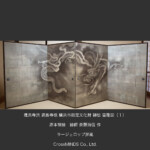Laxerop Folding Screen / ラージェロップ 屏風
Laxerop folding screen as “Japanese art that goes beyond replicas.”
The first approach to Laxerop technology was imaging (printing) on Japanese paper.
The purpose was to find out that “torinoko paper” is used for ancient Japanese fusuma and folding screens.
On the other hand, there is nothing better than the electrophotographic method, which is the texture (color saturation), image durability, and environmentally friendly printing method (image forming method) of sumi-e.
I was convinced.
This is partly because I myself have been involved in electrophotographic technology for many years, but it is also the result of a calm analysis (SWOT) of various recording technologies (image forming technology/printing technology).
What electrophotographic technology will you use in the early days?
Also, since existing technology is difficult, what kind of method should you consider? I spent a lot of time on trial and error.
In that trial and error, it was true that I accidentally found an image forming method (printing method) on Japanese paper suitable for folding screens.
However, when I recall now, I think it was a “short time”, and I was lucky.
Let me give you the details of the technology on another occasion, and here
I would like you to experience Laxerop folding screen as “Japanese art that goes beyond replica”, which is a fusion of new technology and craftsmanship , not just a replica or printed matter. I would like to write about your feelings like,.
“2 Unryu, 1 Shotora, 1 Sansui” in the Manchu-ji Temple of Yokosuka was created by Kaino
Saito, a Kano school painter from the end of the Edo period to the Meiji era.
This is a designated cultural property of Yokohama City, but it is presumed that it was a project by an artist and a painter.
In addition, even when I checked the details when performing this high-resolution digital archive, the description was very impressive.
Also, for the first
Unryu figure I archived , I had to make corrections many times (this is due to my own immorality), and it was almost completed in data correction and Laxerop printing. Even so, I had no choice but to discard it.
Of course, I don’t know the situation at the time when the fusuma picture was drawn, but at that time, it must have been made with a great spirit.
I’m neither an artist nor an artisan, but the colors don’t match, the texture is different, the position is different, and so on.
There are many various obstacles and we have cultivated know-how, but the
biggest obstacle in the first folding screen production is 4 songs per boat, 60 sheets of bird’s child paper (correctly, new bird’s child paper) After they were aligned, they were aligned and cut.
Japanese paper is hard and thick, so it’s difficult to cut with an art cutter, and a Japanese traditional Japanese knife was needed.
Using a special mat recommended by a tableware shop introduced by a long-established Japanese paper shop, and a special ruler and a Japanese knife, 4 sheets of 15 Japanese papers per song are stacked
to create a scaffolding and weight is applied. And cut it all at once.
Precise cutting is impossible without this set of Japanese knife and ruler.
Once you insert the blade, you cannot stop the Japanese knife until the end.
Moreover, if it deviates even a little, it starts over from printing…
With one song, you can go six times and finally you can get 15 folding screen pieces for one song.
Of course, sweat is likely to drip, but it protects.
Then,
to the 60 folding screen pieces that were completed, we made it into a folding screen, so we went to a well-established folding screen shop.
“Is it really possible to make a Laxerop folding screen ??”
” Is n’t this good?” “No, it’s still useless.”
“I’m sorry to Saito Kaishin, too. ,”
To be honest, it was a day when I had that feeling.
Yes, it’s easy to print on a large format printer.
But what is the reproduction of Kaishin Saito’s fusuma picture?
The wonderfulness of making it from scratch, I can feel the thought of Kaishin Saito.
“If you can get a lot of excitement by seeing this Laxerop screen, that’s
what you want .”
It
is undeniable that the original idea of dividing and pasting was to say that there is no laser printer for high-quality art with a width of 900 mm or more and a length of 1,200 mm or more in the world .
We are
confident that the fusuma itself is a pasting, and the texture of the fusuma picture drawn on it is wonderful, and the texture of the fusuma is the folding screen that embodies the spirit of the ancient Japanese craftsmen. I can say that.
The first Laxerop folding screen was completed in this way.
At present, we have reviewed all the processes and added improvements so that a more stable folding screen can be made.
We would like you to experience the Laxerop folding screen as “Japanese art that goes beyond replicas.”
「レプリカを超えたジャパンアート」としての、Laxerop屏風
Laxerop(ラージェロップ )技術の最初のアプローチは、和紙への画像形成(印刷)でした。
その目的は、日本古来の襖や屏風には、「鳥の子紙」が用いられている事を知ったからでした。
一方、墨絵の風合い、彩度(色鮮やかさ)、画像耐久性、そして、環境に優しい印刷方法(画像形成方法)電子写真方式に勝るものは無い、、、。
と、確信しました。
これは、自分自身が、電子写真技術に長年携わっていたからも有りますが、様々な記録技術(画像形成技術・印刷技術)を研究し、冷静に分析(SWOT)した結果でも有ります。
初期は、どんな電子写真技術を用いるか?
また、既存技術では難しいので、どんな手法を考えるか? などの試行錯誤に、多くの時間を費やしました。
そのトライアンドエラーの中で、屏風に適した和紙への画像形成方法(印刷方法)を、偶然見つけた、、、と言うのが真実でした。
ただ、今、思い起こすと、それは、思いがけず「短い時間」であったと思いますし、幸運でした。
技術の詳細は別の機会にさせて頂き、ここでは、Laxerop屏風が単なるレプリカ、印刷物の一つではなく、
新技術と職人技の融合である「レプリカを超えたアート」として、ご体感頂きたい、、、と言う想いについて、書かせて頂きます。
横須賀 満昌寺様に所蔵されている「雲龍図2隻、松虎図1隻、山水図1隻」は、
幕末から明治時代にかけての狩野派の絵師 斉藤海信によるものです。
これは、横浜市指定文化財ですが、絵師と表具師による一つのプロジェクトとであったと、推察されます。
加えて、この高解像度デジタルアーカイブを行う際に、細部を確認しましても、その描写もとても感激するものがありました。
また、最初にアーカイブした雲龍図1隻においては、何度も修正を余儀なく行う羽目になり(これは、私自身の不徳によるものですが)、
データ補正や、Laxerop(ラージェロップ )印刷において、完成間近であっても、破棄せざるを得ない、、、判断をしました。
襖絵を描かれた当時の状況は、勿論存じ得ませんが、当時は、凄い気迫で作られた筈だと、、、。
自分は、芸術家でもありませんし、職人でも有りませんが、色が合わない、これは風合いが違う、位置が違う、、、などなど。
様々な難関は、多く有りますし、ノウハウも培ってきましたが、
最初の屏風制作における最大の難関は、1隻4曲、全60枚の鳥の子紙(正確には、新鳥の子紙)の色味を合わせた後に、位置合わせを行い断裁する事でした。
和紙は硬く、厚いですから、裁断するにも、アート用カッターでは難しく、日本古来の和包丁が必要でした
老舗の和紙屋さんからご紹介頂いた、表具屋さんご推薦の専用マット、そして、専用定規と和包丁を用いて、1曲15枚の和紙を4枚重ね合わせ、
足場を作り、体重を掛けて一気に断裁。
この和包丁と定規のセットでなければ、精密な断裁は無理です。
一度、刃を入れると、最後まで和包丁を止められない、、、。
しかも、それが少しでもズレると、印刷からやり直し、、、。
1曲で、6回行って1曲用の屏風片15枚がやっと出来上がる、、、。
勿論、汗は滴り落ちそうになりますが、それは防御します。
そして、、
出来上がった60枚の屏風片を、屏風に仕立てて頂く為に、老舗の屏風屋さんへ。
「本当に、Laxerop屏風を作る事が出来るのか???」
「これ位の出来で良いのでは無いか?」
「いや、これでは、まだ駄目だ」
「これでは、斉藤海信にも、申し訳ない、、、」
正直、そんな想いが巡る毎日でした。
確かに、大判のプリンターで印刷すれば簡単です。
しかし、斉藤海信の襖絵の再現とは何か?
一から作り上げる事の素晴らしさ、斉藤海信の心意気に想いを馳せる、、、。
「このLaxerop屏風を見て頂く事で、感動を得る事が出来れば、それが本望。」
そう思う様になりました。
横幅900mm以上、長さ1,200mm以上の、高画質なアート用のレーザープリンターが世の中に見当たらない、、、
と言うのが、分割の貼り合わせの当初の発想であったのは否めませんが、
襖自体が貼り合わせで有り、その上に描かれた襖絵の風合いと、その職人技による妙味、
そして、その風合いは、日本古来の職人の心意気も体現した屏風であると、自信を持って言えると思います。
最初のLaxerop屏風は、こうして出来上がりました。
現在は、すべての工程を見直し改良も加え、より安定した屏風が出来る様になりました。
「レプリカを超えたアート」として、Laxerop屏風を、是非、ご体感頂きたいと思います。






